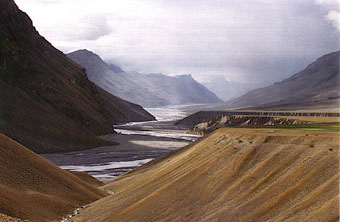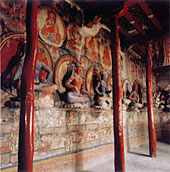| PETERVANHAM.COM BIOGRAPHIES BOOKS MUSIC / FILM PUBLICATIONS & LECTURES NORTHEAST INDIA WESTERN HIMALAYAS PHOTO-ARCHIVES UPCOMING CONTACT |
|||||||
THE FORGOTTEN GODS OF TIBET


SOLD OUT !
"The Forgotten Gods of Tibet - Early Buddhist Art in the Western Himalayas"
Editions Menges, Paris, distributed by Artbooks, London
ISBN 2 8562 0389 2
Vergessene Goetter Tibets - Wiederentdeckung buddhistischer Klosterkunst im Westhimalaya
Belser Verlag, Stuttgart, Zurich
ISBN 3 7630 2245 7
Licensed edition for Switzerland by Verlag Neue Zuercher Zeitung NZZ, Zurich.
ISBN 3 85823 676 4
Les dieux oublies du Tibet - L´art bouddhiste medieval dans l´Himalaya occidental
Editions Menges, Paris
ISBN 2 8562 0389 2
Foreword by His Holiness, the Dalai Lama
Preface by Madanjeet Singh (UNESCO)
Price: EURO 50.00, USD 50.00
The Region:
Spiti and Kinnaur, two culturally Tibetan regions in the Indian Western Himalayas, were inaccessible for the last 40 years. They are located in immediate proximity to the former spiritual centres of Western Tibet (the kingdom of Guge, Tholing, Tsaparang - nowadays extinct), with whom they were formerly connected.
Since politically on Indian territory, the cultural sites located in the area have survived the destructions that took place in Tibet in the 50´s.
The region is characterized by incomparable grandeur of mountain deserts with villages lying between 3500 and 4300 metres above sealevel.

In Spiti and Kinnaur we find Buddhist monasteries of unique historic and cultural importance:
• They are the most ancient monasteries of the entire Tibetan world that have survived in their original state. (Foundation dates: Tabo 996 A.D., Nako 1025 A.D., Lhalung 1130 A.D.). In Tibet itself comparingly ancient monasteries have been destroyed or repainted.
• The monasteries house incomparable murals and sculptures of worldrank. Here one finds the largest assemblage of Indian influenced early Tibetan art preserved in its original state of execution from 1000 till 800 years ago. Some of the only „living“ examples of the extremely rare and aesthetically precious since very refined Kashmiri and Kadampa styles of art (normally only known from bronzes and painted scrolls). Most of the few references of these styles are kept in the Metroplitan Museum of Art, New York. This is also the reason for the UNESCO´s enthusiasm about this book (preface by Madanjeet Singh).
• Due to their notable state of preservation these monasteries immediately tell about the spiritual background of the „Second propagation of Buddhism in Tibet“, a movement that started from these monasteries (especially Tabo) in the 10th and 11th century A.D. and which led to the final conversion of the entire Tibet to the Buddhist faith. Its advocates (Rinchen Zangpo, Atisha, Domton, Yeshe O) were the founders and designers of the monasteries described in this publication. The philosophical concepts found in these monasteries therefore are testimonies of the ideas of this movement. Thanks to these historical persons and their translations of Indian Buddhist texts many important parts of Buddhism have been preserved which otherwise would have been lost forever.
• The monastery of Tabo is the only religious site in the world where one can enter a three-dimensional mandala. Designed on the basis of the early Tibetan Buddhism, 32 stucco images on the four main temple walls and one central deity let the entering become the centre of the mandala himself. The famous Italian tibetologist Guiseppe Tucci has called Tabo the historico-culturally most important Tibetan monastery. It is spiritually connected with the largest Buddhist building of the world - the stupa of Borobudur at Java.
• As the Dalai Lama mentions in the foreword to this book, these monasteries are especially important to him. He has given the Kalachakra initiation at Tabo in 1996 on the occasion of its 1000th year of existence. His most important teacher, his master of debate, Tsen-shap Serkong Rinpoche was inthronised at Tabo as abbot of the monastery since his exile in the 60s. His young reincarnation again has been inthronised here

"The Forgotten Gods of Tibet" is the first and only comprehensive documentation with 185 colour photos about the five most important monasteries of the region - Tabo, Lhalung, Nako, Dhankar, Pooh => standard work. The historic and philosophical / psychological connections are described in detail and in appealing manner (eight maps and graphs).
Because of the different styles of different epochs frequent in the temples, the book is also a comprehensive description of Tibetan art in general. Rare views of important pieces of art published for the first time ever.
In 1933 the famous Italian tibetologist Tucci dedicated one of the books of his series `Indo-Tibetica´ to the region. Through "The Forgotten Gods of Tibet" a rediscovery in phototechnically appealing manner of what Tucci photographed for mere documentary reasons has become possible.
The book is published in three different editions (English, French and German)
Along with the book an Audio CD entitled "TABO - Mandala in Stone" was released. It features the music of Peter van Ham´s multivisional show on Tabo monastery.

- FOREWORD BY HIS HOLINESS, THE DALAI LAMA
PREFACE BY MADANJEET SINGH -SPECIAL ADVISOR TO THE DIRECTOR GENERAL OF THE UNESCO
– INTRODUCTION
– THE REALM OF THE DIVINE – PEOPLE, ROCKS AND DEMONS
A Sociocultural Geography of Spiti
– Geographical setting
– Spiti
– History
– ADVOCATES OF THE DIVINE – ON THE TRAIL OF THE GREAT LOTSAVA
The Tradition of Rinchen Zangpo in the Western Himalayas
– ASPECTS OF THE DIVINE – THE ART OF SPITI
- The Historical Background of the Tantric Philosophy
- The Philosophical Concept of the Mandala and Tibetan Art
- Vajradhatu Mandala
- Stylistic and Thematic Characteristics of Early Western Tibetan Art
- TESTIMONIES OF THE DIVINE - RELIGIOUS SITES OF SPITI
- Tabo
- Introduction
- Layout and Artistic Decoration of the Temples
- The Outer Structure of the Tabo Chokhor
- Tsug Lhakang and Gokhang
- The Statues
- The Paintings
- The Murals Depicting the Legend of Sudhana
- The Murals Depicting the Life of Buddha
- Paintings of the Middle and Upper Register
- The Apse
- Gonkhang
- Domton Lhakang Chenpo
- Serkhang
- Kyilkhang
- Chamba Chenpo Lhakang
- Domton Lhakang
- Karchung Lhakang
- Pho Gompa
- Tabo in Recent Times
- Dhankar
- Lha O-pa Gompa
- Lhakang Gongma
- Lhalung
- Serkhang
- The Statues
- The Paintings
- Nako
- Nako Chokhor
- Pooh
- GLOSSARY
- BIBLIOGRAPHY
- ACKNOWLEDGEMENTS